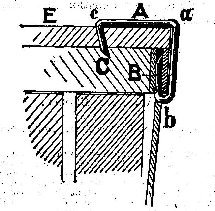
WINNE v. BEDELL.
Circuit Court, D. New York.
November 8, 1889.
PATENTS FOR INVENTIONS—INFRINGEMENT—BASKET-COVER FASTENINGS.
The claim of letters patent No, 221,203, issued November 4, 1879, for an Improvement in basket-cover fastenings, was for a combination of (1) a box or basket; (2) a cover on the basket; and (8) a metallic fastener, at one end of which there is a hook attached to the hoop of the basket, at the opposite end a bend at an acute angle, provided with a sharp point, which is driven into the basket cover, and in the middle a rectangular bend. The specifications said that the fastener device could be used in a certain manner without the middle bend but the original claim, being for the fastener, was rejected, and the claim was amended. Held, that sale of the fastener without the middle bend, alone, did not infringe the patent, and as it was capable of innocent use, it was immaterial that it was also capable of being bent so as to infringe.
In Equity. Bill for infringement of patent.
William H. King, for complainant.
Arthur v. Brieseh, for defendant.
COXE, J. This is an action of infringement, based upon letters patent No. 221,203, dated November 4, 1879, for an improvement in basket cover fastenings. The specification says:
The invention consists in the combination, with a box and its cover, of a metallic bar bent to form at one end a close hook, bent again rectangularly near the middle, bent again near the other end at an acute angle, and provided with a sharp point for entering the top of the coyer. * * * This device may also be used for the purpose of securing the covers of paper bandboxes and other similar articles. When used for that purpose, the hook, B, is inserted in the top of the cover, the body of the device extending down the side of the box, into which the point, C, is inserted, and is retained in place by the hold produced by its angle. * * * I do not broadly claim a metallic bar Or rod bent into shape for holding a basket cover on a basket, being aware that such is not broadly new; but what I do claim is “
In combination with a, box and its cover E, a metallic bar, A bent at b 464to form at one end the close hook, B, bent again rectangularly near the middle at a, and having near the other end a bend, c, forming an acute angle, and having a sharp point, C, forced through the cover, to complete a firm fastening.”
The claim is therefore for a combination consisting of the following elements First, a box or basket; second, a cover on the basket; third, a metallic fastener, at one end of which there is a hook attached to the hoop of the basket, at the opposite end a bend at an acute angle, provided with a sharp point, which is driven into the basket cover, and in the middle a rectangular bend. The following diagram will serve to illustrate the combination of the claim:

Fig. 1 of the drawings shows the fastening device without the rectangular bend.

Originally, the applicant sought to cover this device, but was rejected upon various references. It was not until he had abandoned the claim for the fastener, and had explicitly stated that “the claim is now no longer for the fastening bar per se, either before or after application, that the patent was issued in its present restricted form. The defendant sells “the fastening bar per se,” as shown in Fig. 1. There is no evidence that he has at any time used the patented combination, or sold the fastener with the rectangular bend in the middle. In this connection, it should be remembered that the specification describes the use of the straight fastener for securing, the covers of paper boxes.
The question, then, is this: Can the complainant, who has described a straight fastener, and a use to which it may be put, but has not claimed the straight fastener, either singly or in combination, maintain infringement against one who sells the fastener in this form only? 465Manifestly not. The defendant has not adopted the combination of the claim. He sells but one element of it. It is urged that he should be held liable because his device “is capable of being bent” so as to infringe. But this argument would apply with equal force to an umbrella-slide holder, a bale-tie, or a hair-pin. The complainant cannot invoke the doctrine of Wallace v. Holmes, 9 Blatchf. 65, and analogous authorities, for the obvious reason that the defendant's fastener is susceptible of a perfectly legitimate use, which the complainant himself has taken pains to point out, Snyder v. Bunnell, 29 Fed. Rep. 47. To justify a decree for infringement, actual proof must be presented of the defendant's illegal acts. It will not do to substitute therefor suspicion and conjecture. As the complainant must fail upon this branch of the case, it is unnecessary to examine the other defenses presented. The bill is dismissed.
This volume of American Law was transcribed for use on the Internet
through a contribution from Google. 